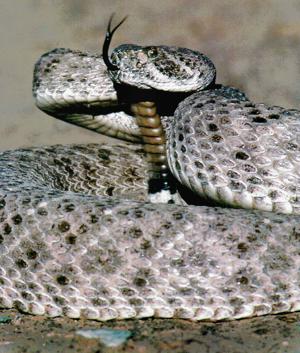Trail Dust: Rattlesnakes are subject of much Southwestern lore
Posted: Friday, September 4, 2015 7:00 pm | Updated: 12:12 am, Sat Sep 5, 2015.
Rattlesnakes are not one of my favorite creatures in this Southwestern homeland. But I’ll be the first to admit that they add something of interest to the region. Around them, a huge body of lore has accumulated.
Most people, I suppose, have a natural fear of rattlers, because they are venomous and so kill human beings from time to time.
In fact, the 16-year-old son of my great uncle was struck in the calf by a Texas diamondback down along the Nueces River. It happened in a remote area, and before they could get the boy to a hospital, he died.
I thought of that once when I was hiking on rough trail in the Canadian breaks of the Panhandle. Suddenly, I heard a loud whirring, and there coiled on a rock was the largest rattlesnake I’d ever seen.
It was as thick as my upper arm and would probably have measured 6 to 7 feet stretched out. Wanting to avoid a second snake death in my family, I made a wide detour around him.
During my cowpunching days in Wyoming, I would sometimes have to drive cattle through thick stands of buckbrush. You could hear the buzzing of rattlers to the right and left, but seldom see them. They would be on my mind, and sometimes when I had bedded down by the campfire, I dreamed that a snake had crawled under my saddle, which I was using as a pillow.
I’d awake suddenly and come flying out of the blankets. Then I would make a search to be sure Mr. Serpent was not sharing my bed.
That sometimes happened to old-time cowboys, especially when they were camped out in cold weather. Rattlers, seeking warmth, would move into their bedding and go to sleep.
To discourage that, the men often surrounded their blankets with a prickly hair rope, laid on the ground. They firmly believed that snakes would avoid slithering over such a rope, since the scratchy bristles tickled their bellies.
I never put much faith in that old superstition. And besides, my up-to-date catch rope was made of smooth nylon, so it wouldn’t have been much use as a snake shield.
In going through the burial records of colonial New Mexico, I’ve noticed a number of cases in which the cause of death is rattlesnake bite. The Spanish settlers must have known numerous folk remedies for such biittes, but the only one I have discovered is a poultice made by cooking cockleburs.
At a later day, Anglo fur trappers spit tobacco juice on a fresh bite, convinced somehow that it diluted the venom. Another remedy, universally prescribed on the frontier, was the drinking of whiskey. While it might temporarily ease the pain, in the long run alcohol caused the bite victim more harm than good.
Frontiersman Nelson Lee, in his memoirs, tells of a cure that saved his life in the 1850s. He had just dismounted from his horse in a mesquite thicket when an enormous rattlesnake struck him in the ankle.
As he recounted it: “A sickening, dreadful sensation came over me, terrible beyond all force of language to convey. With the prospect of dying in such an abominable way, my nerves became completely unstrung.”
According to Nelson, a Spaniard in his party who had witnessed the incident came up and quickly killed the snake. Then he began cutting portions of flesh from the still wriggling monster and applying them to the bite.
“I could feel the reptile’s flesh draw, and in a few minutes the white poultice thus applied changed to a perfect green. These applications proved effectual, inasmuch as I suffered nothing from it afterwards save a slight soreness.”
The dread and loathing of rattlesnakes experienced by most men meant that the creatures were usually killed on sight. Drovers walking beside their ox teams kept an eye peeled for snakes, and upon spotting one would skillfully take off the head with a well-aimed snap of their heavy bullwhips.
Early-day prospectors along the Pecos River were always poking into shallow caves in the cliffs, looking for signs of minerals. Sometimes they would encounter a snake cave, filled with a seething mass of rattlers.
The usual response was to toss a stick of dynamite into the opening, reducing the rattlesnakes to hamburger. To what extent the long war against rattlers has depleted their numbers, we can only guess.
Folklorist J. Frank Dobie once wrote a book called simply, Rattlesnakes. It is the most readable source I know dealing with snake lore in the Southwest, and I can recommend it to all those with an interest in pursuing the subject.











No comments:
Post a Comment